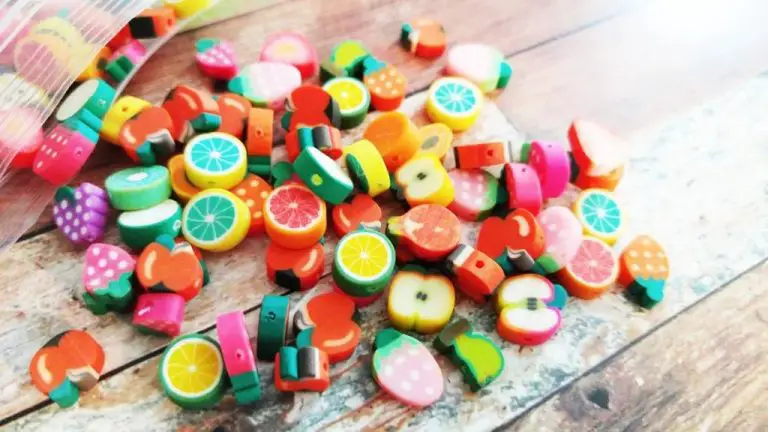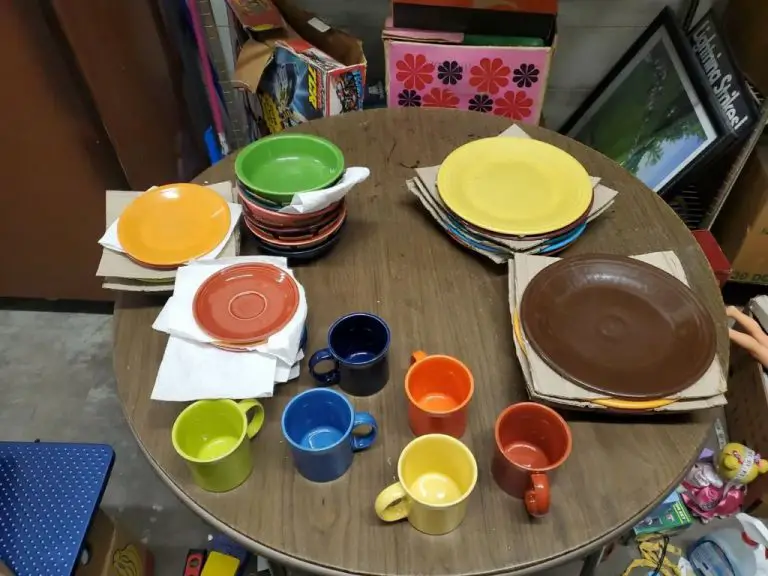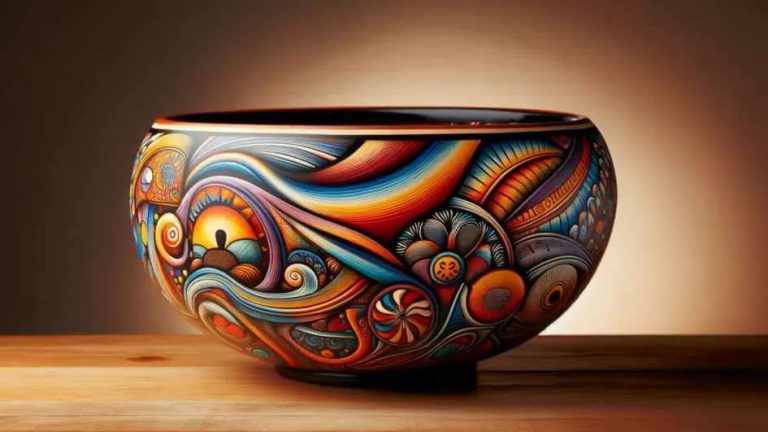What Clay Do Most Potters Use?
Clay is the primary material used by potters to create pottery. Potters sculpt clay into objects like bowls, cups, vases, and more. The word “ceramics” is used to describe items made out of clay that have been permanently hardened by firing at high temperatures. Clay has unique properties that make it ideal for shaping into pottery. When mixed with water, clay becomes flexible and can be molded into 3D forms. When fired, the clay hardens into a permanent solid shape. Clay comes from the earth, and potters have been crafting it into pottery for thousands of years across many cultures. From functional dishes to decorative art, potters worldwide work with clay to make beautiful and useful ceramic objects.
Types of Clay
There are three main types of clay that potters use:
Earthenware
Earthenware is a low-fire clay that is porous when fired. It can be fired at lower temperatures ranging from 1650°F to 2200°F. Earthenware clays contain a significant amount of iron and other impurities which causes them to fire to a reddish-orange color. Earthenware is less durable than stoneware and porcelain but is more forgiving and easier to work with making it a good choice for beginner potters.
Stoneware
Stoneware is a mid-range fire clay that becomes vitrified and non-porous when fired to higher temperatures ranging from 2200°F to 2400°F. The vitrification makes stoneware stronger and more durable than earthenware. Stoneware clays come in a range of colors from light grey to dark brown depending on the mineral composition. Mid-range stoneware clays are versatile and used for functional ware as well as sculptural pieces.
Porcelain
Porcelain is a high-fire white clay that fires to a smooth, glass-like finish. It is fired between 2250°F and 2350°F. Porcelain contains kaolin clay that gives it a high resistance to water absorption making it ideal for functional pieces. It requires more specialized glazes than stoneware and can be more challenging to work with. Porcelain is known for its thin translucent qualities in sculptural and decorative wares.
Properties of Clay
Clay has several important properties that make it well-suited for pottery and ceramics. The three main properties are plasticity, shrinkage, and porosity.
Plasticity refers to clay’s ability to be shaped and molded without cracking or crumbling. When clay is mixed with water it becomes soft and pliable. This allows potters to form clay into a variety of shapes and sizes using techniques like throwing, handbuilding, and molding. Plasticity makes clay an ideal material for creating both functional pottery and artistic ceramic sculpture.
Shrinkage occurs as clay dries and loses moisture. The clay particles move closer together causing the overall size to decrease slightly. Shrinkage continues during firing as water is driven out of the clay. The amount of shrinkage depends on the clay body but is predictable allowing potters to account for size changes when designing pieces. Controlling shrinkage is key to ensuring pottery remains structurally sound during drying and firing.
Porosity describes the tiny holes and spaces within the clay’s structure. These pores absorb water which allows the clay to become plastic. During firing, porosity changes as vitrification occurs and the pores close up. The final porosity of a fired piece impacts properties like strength and whether the piece can hold water without leaking.
Sourcing Clay
Potters can source their clay in a variety of ways. The two main options are to dig and process the clay locally or to buy commercially prepared clay.
Digging clay locally can allow a potter to find high quality, natural clay deposits. However, this requires the ability to locate appropriate clay deposits and the effort to dig and transport the clay. The clay will also need extensive processing such as breaking up lumps, removing rocks and organic contaminants, and aging or ‘souring’ it.
Buying commercially prepared clay is convenient and skips the laborious process of sourcing and processing raw clay. Reputable clay companies provide consistent, high quality clays that are ready to use after some wedging and kneading. Common types of commercial pottery clays include stoneware, porcelain, earthenware and others. The downside is the cost compared to freely sourced local clay.
Preparing Clay
Before clay can be worked into a desired shape, it must be prepared through wedging, slaking, and kneading.
Wedging is the process of cutting and recombining clay to form a uniform consistency. This removes air pockets that can cause cracking or bursting in the kiln. To wedge, cut the clay into chunks and slam it against the wedging table, then fold it over itself and repeat. Do this until the clay feels smooth, with no grittiness.
Slaking means mixing clay with water to achieve an ideal plasticity. Add small amounts of water and knead thoroughly between palms until clay feels smooth and plyable. Test consistency by making a coil – proper moisture will hold its shape without sagging or cracking. Too little water makes clay crumbly, while too much makes it sticky.
Kneading clay by hand or machine aligns particles for an even texture. Regular kneading also removes air bubbles. Push clay down and away, folding it over itself. Continue kneading until the clay feels soft, flexible, and free of lumps.
Proper wedging, slaking, and kneading ensures clay has the right moisture content and consistency for successful forming and firing. Well-prepared clay is smooth, plyable, and free of flaws.
Forming Methods
There are three primary methods that potters use to shape clay into pottery:
Wheel Throwing
Wheel throwing is one of the most popular methods for forming pottery. The potter uses a potter’s wheel to shape clay into symmetrical forms. As the wheel spins, the potter uses their hands to manipulate the clay, opening the center, raising the walls, and shaping the piece. Wheel throwing requires practice to perfect, but allows potters to make multiples of the same shape and size.
Hand Building
Hand building encompasses techniques like pinch pots, coil building, and slab construction. With pinch pots, potters use their fingers and thumbs to shape the clay walls from a ball of clay. Coil building involves rolling out and stacking ropes of clay to build up vessel walls. Slab construction uses flat pieces of clay that are joined together to make the form. Hand building gives potters more control over asymmetry and texture in their pieces.
Molds
Potters can make plaster molds to form multiples of the same shape. The clay is pressed into the mold and allowed to stiffen before being removed. Molds allow for consistency in production and intricate detailing. They can be used for complex shapes or pieces with relief decoration.
Drying Clay
Before clay can be fired in a kiln, it must be thoroughly dried. This is an important step, as any moisture left in the clay will evaporate during firing and potentially ruin the piece. There are two main methods for drying clay:
Controlled air drying involves letting clay air dry slowly under controlled conditions. Clay is left to dry on a shelf or table away from direct sunlight and drafts. The temperature and humidity of the room needs to be monitored to prevent the clay from drying too quickly. Going too fast can cause cracking or warping. As clay dries, it shrinks slightly so must be allowed to reduce evenly. Turning the clay periodically allows even drying.
Using a kiln is a faster way to dry clay. The clay is placed inside a kiln on low heat between 150-200°F. This gently evaporates any moisture left in the clay after air drying. The process takes between 12-48 hours depending on the size and thickness of the clay piece. Using a kiln helps prevent cracks and distortion during drying. Once bone dry, the clay is ready to be fired to a higher temperature to permanently harden it.
Firing Clay
Firing, also known as burning, is the process of exposing clay to high temperatures in a kiln to cause permanent changes in its chemical and physical properties. This makes the clay harder and less porous. There are several different types of kilns used for firing clay, and the process typically involves two main stages – bisque firing and glaze firing. Specific techniques like raku firing and pit firing can also be used to achieve unique effects.
Bisque firing refers to the initial firing cycle, which can range from cone 04 (around 1,045°C or 1,900°F) up to cone 6 (around 1,240°C or 2,265°F). During bisque firing, clay becomes vitrified as water evaporates, organic material burns out, and chemical bonding begins. The result is a durable, semi-porous ceramic body ready for glazing and decorating. Bisque firing is done in electric kilns, gas kilns, or wood-fired kilns.
Glaze firing is the second firing process, where ceramic pieces already bisque fired are coated in glaze and fired again to fuse the glaze permanently to the clay body. Typical glaze firing temperatures range from cone 4-10 (1,060°C to 1,325°C or 1,940°F to 2,420°F), depending on the clay and glaze materials used. Glaze firing can create colors, textures, and effects impossible to achieve with clay alone. Electric and gas kilns allow precise glaze firing, while wood-fired kilns yield unique effects from ash and flame.
Raku firing involves removing clay pieces from the kiln while still glowing hot, then placing them into containers with combustible materials like sawdust or leaves. This produces dramatic thermal shock effects on the glazes. Pit firing relies on an open pit dug into the ground and filled with wood or other organic matter for fuel. Pots are placed in the pit and covered to allow smoke penetration during firing.
Choosing the right firing technique is essential for potters to permanently harden their clay work and achieve their desired colors, textures, and styles. From functional ware to decorative sculptures, the possibilities are nearly endless when the right clays and glazes are combined with the transformative power of firing.
Glazing
One of the final and most creative steps in pottery making is glazing. Glazes are coatings applied to pottery that serve both decorative and functional purposes. Glazes come in endless colors, textures, and finishes, allowing potters to add beauty, color, and their artistic touch to a finished piece.
Glazes have two major roles. First, they decorate the pottery, allowing it to be adorned with colors, patterns, and artistic effects. Glazes with coloring oxides can create a vibrant rainbow of colors and patterns like dripping, cracking, or peeling effects. Decorative elements like prints, textures, and painted designs can be incorporated under or on top of glazes. Glazes provide an avenue for potters to enhance their works with beautiful, creative finishes.
Secondly, glazes protect the pottery and make it functional. When fired, glazes form a glassy coating that is waterproof, durable, and seals the clay surface. This prevents leaking on containers like mugs, bowls, and vases. The glaze coating also protects the clay from absorbing liquids and from staining. A glazed pottery surface is non-porous, hygienic and easy to clean. Glazes transform soft, porous clay into a functional, useable ceramic material. So glazing plays an integral role in making pottery suitable for decorative use or everyday functions.
When working with glazes, potters must consider factors like color, texture, firing temperature, and application method. Glazes can be applied by dipping, pouring, brushing, or spraying. The pottery surface and thickness of the glaze application will affect the final results. By learning how different glazes interact with clay bodies and mastering application techniques, potters can discover their own artistic style of glazing.
In summary, glazing allows potters to complete their works by decorating the surfaces with beautiful colors and effects, while also making the pottery functional by sealing it with a protective glass coating. Glazing transforms plain clay into vivid, useable art.
Conclusion
Clay is an integral material for pottery making and has been used by potters for thousands of years. The unique plasticity of clay allows it to be shaped into a multitude of forms and holds its shape as it dries and is fired in a kiln. Choosing the right type of clay is crucial, as its composition affects its working properties, how it responds to firing temperatures, and the types of glazes that can be used. Preparing the clay properly through wedging, aging, and mixing additives helps improve its workability and durability. Mastering different forming techniques like throwing, handbuilding, and moulding allows potters to create both functional wares and artistic sculptural pieces. Though time-consuming, the process of properly drying and firing clay is vital for evaporating moisture, hardening and strengthening the clay, and preparing it for the application of glazes and enamels. While clay starts as an earthy, malleable substance, in the hands of a skilled artisan it can be transformed into objects of remarkable beauty, purpose and longevity through the alchemy of ceramics.



